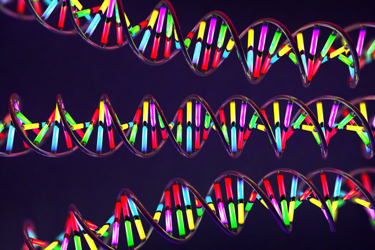Therapeutic Oligonucleotides: Regulations & Quality Standards
By Sarita K. Acharya and Christian Zeine, U.S. Pharmacopeia (USP)

Oligonucleotides have been researched for their therapeutic properties for decades and have surfaced in the past few years as promising therapeutic agents for the treatment of various diseases including neurodegenerative disorders, respiratory disorders, cancer, and diabetic retinopathy.1 There are several classes of nucleic acids being investigated for oligonucleotide-based therapeutics, such as antisense, small interfering RNAs (siRNAs), and aptamers. DNA and RNA oligonucleotides are chemically synthesized using nucleic acid monomers known as phosphoramidites. However, the repetitive nature of the oligonucleotide synthesis will amplify the impact that phosphoramidite impurities may have, resulting in poor final oligonucleotide quality. So, the quality of the raw materials has a major impact on the quality of the drug since some of these impurities can be incorporated into the therapeutic oligo final product and be difficult to purify. Therefore, raw material impurities that arise need to be controlled and monitored by establishing limits based on the safety and process capability to ensure that the quality and performance of the drug are not compromised.
Key challenges in the development and manufacturing of oligonucleotide therapeutics are the analytical methods for the identification and quantitation of impurities associated with the raw materials and the final drug substance. These challenges were explored during the USP-hosted workshop on “Therapeutic Peptides and Oligonucleotides: Regulations and Quality Standards,” held virtually in February/March 2022, which included more than 350 participants from regulatory agencies, industry, and academia. Experts shared their insights on multiple topics, including key considerations for the design and development of analytical methods with case studies focusing on identification and characterization of impurities. This article highlights topics and themes related to oligonucleotides identified throughout the three-day workshop.
Regulatory And Compendial Considerations For Oligonucleotides
While there is currently a lack of dedicated International Council for Harmonization (ICH), European Medicines Agency (EMA), or FDA regulatory guidelines that specifically address the quality aspect and expectations for synthetic oligonucleotide therapeutics, some successful programs built their strategy based on regulatory guidelines used for small molecules and synthetic peptides to define key quality attributes and to design analytical programs.
USP staff member Sarita K. Acharya highlighted their work on phosphoramidite-based raw materials and Deyi Zhang from the FDA presented some of the regulatory challenges, including lack of consensus on impurity reporting, identification, and qualification thresholds. To address these challenges, FDA’s Office of Generic Drugs (OGD) within the Center for Drug Evaluation and Research (CDER) has released product-specific draft guidance on oligonucleotides (e.g., nusinersen sodium – one of the first oligonucleotide drugs approved on the market) to provide recommendations for the development of a generic for that oligonucleotide therapeutics. This guidance will include analytical approaches to characterize the product and ways to evaluate impurities to ensure that the generic product will not alter the safety and efficacy as compared to the reference drug product.
There were also discussions on the current chemistry, manufacturing, and controls (CMC) regulatory experiences and expectations for oligonucleotides. René Thürmer from BfArM in Germany stressed the importance of starting material as part of the overall control strategy. He also highlighted the importance of stress testing and identity testing along with orthogonal methods for oligonucleotide purity assessment. For example, an orthogonal combination of reverse-phase high-performance liquid chromatography (RP-HPLC) coupled to mass spectrometry and ion exchange chromatography coupled with UV detection will be more powerful than a single LC-MS method. For instance, one of the most common types of impurities is a "deletion" of one or two nucleotides, which leads to an n-1 or n-2 impurity. While these impurities can vary in the location of the deletion, they all arise from a failure during coupling steps and can be grouped together. However, the grouping strategy should be justified during filing by the applicant when setting specifications.
Chemical synthesis of therapeutic oligonucleotides is commonly performed using phosphoramidites in a four-step cycle including detritylation, coupling, capping, and oxidation/thiolation. Elaine Fowler from AstraZeneca explained how their platform approaches to new modalities like oligonucleotide products are accelerating development timelines. Focusing on the common structural elements (e.g., solid phase synthesis process, degradation pathways, drug product manufacturing process, and formulation pH) provides opportunities to streamline processes and expedite the development and regulatory submissions.
Analytical Tools And Advances To Ensure Quality
As the therapeutic oligonucleotide pipeline continues to grow globally, manufacturers are learning how to overcome some of the analytical and process challenges that help ensure quality. Dennis Rhodes from Ionis shared ways to improve method performance by optimizing mobile phase buffers, pH, different column loads, and flow rates. He demonstrated the improvement in the resolution of critical impurities from the main peak from an ultra-high performance liquid chromatography/mass spectrometry (UHPLC/MS) method over that previously seen with an HPLC/MS method.
Other advances in analytical tools to ensure oligonucleotide purity included in-depth impurity profiling by high-resolution mass spectrometry, as presented by Kui Yang from the FDA. She highlighted the use of high- and low-resolution MS (HRMS) for full-length product identification and characterization of coeluting isobaric impurities. She presented two case studies: one for the characterization of almost isobaric impurities such as N-C and N-U and another that used HRMS to analyze impurities that are isobaric to full-length products, exploiting their isotopic distribution patterns.
The usual chemical process to incorporate phosphorothioates during oligo synthesis results in the creation of two stereo-isomers [RP and SP]. Philip Ross from Wave Life Sciences discussed the stereo-pure method used at Wave that results in linkages with stereo-pure RP or SP configuration.
There are also improvements and progress being made with the traditional approach of therapeutic oligo synthesis and the various chromatographic techniques used to evaluate them. For instance, Giovanni Calderisi from Bachem presented LC-MS data supporting process development that used ultra-high-resolution MS to characterize their modified oligonucleotides. LC-MS/MS was also used to investigate the location of PO-PS substitution in the sequence. However, sequence confirmation using LC-MS/MS is challenging, and low signal intensity makes it difficult to achieve full sequence coverage. Calderisi demonstrated that skipping the chromatography and adding a desalting step prior to direct infusion eliminates sodium adducts and improves signal quality, allowing both strands to be analyzed in a single experiment.
Andrew Argo from Biogen shared data generated from screening reverse phase columns, which showed improvements in speed and resolution using C8 and phenylhexyl column chemistries. Although MS is a method of choice to directly obtain structural information about oligonucleotide therapeutics, due to challenges with the sensitivity of the method, he recommended a combination of techniques such as ion-pair chromatography, anion exchange, and/or HILIC methods to properly analyze the product.
Manufacturing And Raw Material Considerations
Manufacturing of therapeutic oligos differs between upstream processes, which are solvent-heavy, and downstream processes, which are more water-based. Therefore, the quality and quantity of raw materials are important in oligonucleotide manufacturing.
Hagen Cramer from QurAlis presented some impurities that were detected in support and phosphoramidite raw materials, as well as some process-related impurities. He demonstrated the use of high-resolution LC-MS to trace the origin of each impurity back to the respective process step. Cramer also emphasized the relevance of the ICH Q3 guideline; although oligonucleotides are excluded and no other guidelines on process-related impurities are available, principles of the ICH Q3 can still be applied. He also suggested following guidelines outlined in a white paper by the Oligonucleotide Safety Working Group (OSWG), which proposes to classify impurities into four different classes and assesses safety only for impurities that contain structural elements not found in the parent oligonucleotide.
Next Steps
Recordings of many of the workshop talks can be accessed on USP’s Education site. USP continues to engage stakeholders to develop tools and solutions needed to ensure oligonucleotide therapeutics quality throughout development, control, and release. Stakeholders across the industry are encouraged to engage with USP on oligonucleotide standard development or to suggest topics for next year’s workshop by contacting Sarita K. Acharya, principal scientist in USP’s Global Biologics department at Sarita.acharya@usp.org.
References
- Mehta, M., Deeksha, Tewari, D., Gupta, G., Awasthi, R., Singh, H., Pandey, P., Chellappan, D. K., Wadhwa, R., Collet, T., Hansbro, P. M., Kumar, S. R., Thangavelu, L., Negi, P., Dua, K., & Satija, S. (2019). Oligonucleotide therapy: An emerging focus area for drug delivery in chronic inflammatory respiratory diseases. Chemico-Biological Interactions, 308, 206–215. https://doi.org/10.1016/j.cbi.2019.05.028
About The Authors:
 Sarita K. Acharya, M.S., is a principal scientist in the global biologics department at USP. Prior to joining USP, she worked for several biotech companies, academia, contract research organizations, and pharmaceutical companies, including GlaxoSmithKline (GSK) and Janssen Pharmaceuticals. She has held several lab-based roles in method development and validation, CMC, and quality control, and she has worked on monoclonal antibodies and protein- and mRNA-based vaccines. At USP, Acharya identifies and advances development of standards to support vaccine manufacturing, analytical testing of monoclonal antibodies, oligonucleotides, genomics, and personalized medicine.
Sarita K. Acharya, M.S., is a principal scientist in the global biologics department at USP. Prior to joining USP, she worked for several biotech companies, academia, contract research organizations, and pharmaceutical companies, including GlaxoSmithKline (GSK) and Janssen Pharmaceuticals. She has held several lab-based roles in method development and validation, CMC, and quality control, and she has worked on monoclonal antibodies and protein- and mRNA-based vaccines. At USP, Acharya identifies and advances development of standards to support vaccine manufacturing, analytical testing of monoclonal antibodies, oligonucleotides, genomics, and personalized medicine.
 Christian Zeine, Ph.D., is senior manager of scientific affairs for the EMEA region at USP. In addition to collaborating with scientific experts and stakeholders, he focuses on small molecules, USP’s general chapters, and biologics. Before joining USP, he worked for 17 years in the field of pharmaceutical reference standards with a focus on impurities, and he also spent time in the in vitro diagnostics industry. He has published articles and white papers on impurities, overviews of certified reference materials, and the use of reference standards in method development and validation.
Christian Zeine, Ph.D., is senior manager of scientific affairs for the EMEA region at USP. In addition to collaborating with scientific experts and stakeholders, he focuses on small molecules, USP’s general chapters, and biologics. Before joining USP, he worked for 17 years in the field of pharmaceutical reference standards with a focus on impurities, and he also spent time in the in vitro diagnostics industry. He has published articles and white papers on impurities, overviews of certified reference materials, and the use of reference standards in method development and validation.
